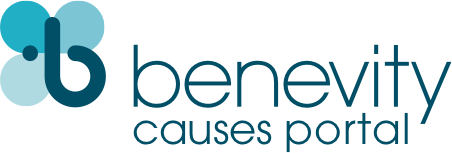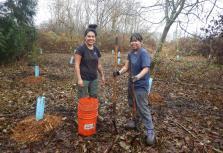
Opportunity Details
Band together with NSEA as we work to restore habitat for Chum and Coho salmon along a tributary of California Creek. Find out more and register at n-sea.org/stream-stewardsAvailable Shifts
| Shift Name | Signup Max | Start | End |
|---|---|---|---|
| General | no limit | n/a | n/a |
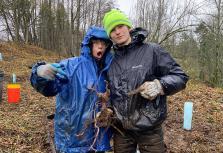
Opportunity Details
Venture out to a long-term riparian restoration site with NSEA! We will be removing invasive Himalayan Blackberry along Terrell Creek. Find out more and register at n-sea.org/stream-stewardsAvailable Shifts
| Shift Name | Signup Max | Start | End |
|---|---|---|---|
| General | no limit | n/a | n/a |

Opportunity Details
Keep Lee County Beautiful, Inc. (KLCB), a private non-profit organization, is organizing the annual Marine Cleanup a.k.a. “Monofilament Madness”. The goals of the cleanup are to remove unsightly and environmentally harmful fishing line and marine debris from the waterways and mangroves. The volunteers will spend their day cleaning up the mess carelessly left by others in order to raise public awareness about this preventable litter problem and the life threatening circumstances it poses for marine life. More than 200 boaters, kayakers and jet skiers are expected to launch their boats and physically remove the floating debris and monofilament fishing line.Available Shifts
| Shift Name | Signup Max | Start | End |
|---|---|---|---|
| General | no limit | n/a | n/a |
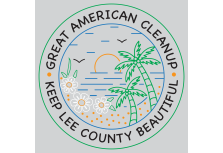
Opportunity Details
Join us for the 25th anniversary of Keep Lee County Beautiful's Great American Cleanup, aka "Trash Bash!"We will provide the cleanup supplies, but encourage volunteers to bring their own reusable water bottle from home. We will have water, garbage bags, latex gloves, and hand sanitizer. Also remember to bring your sunscreen!
Event T-shirts (small- XL) provided on a first come, first serve basis.
If you have any questions please email Sarah@klcb.org or call 239-334-3488.
Available Shifts
| Shift Name | Signup Max | Start | End |
|---|---|---|---|
| General | no limit | n/a | n/a |
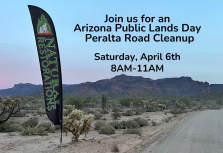
Opportunity Details
Join Natural Restorations as we team up with Pinal County Parks & Trails for a Peralta Road Cleanup on Arizona Public Lands Day. Event details & registration: https://www.eventbrite.com/e/851784168377?aff=oddtdtcreatorEveryone is welcome, including youth volunteers when they are accompanied & supervised by a parent, guardian, or adult group leader.
Available Shifts
| Shift Name | Signup Max | Start | End |
|---|---|---|---|
| General | no limit | n/a | n/a |
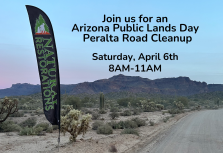
Opportunity Details
Join Natural Restorations as we team up with Pinal County Parks & Trails for a Peralta Road Cleanup on Arizona Public Lands Day. Event details & registration: https://www.eventbrite.com/e/851784168377?aff=oddtdtcreatorEveryone is welcome, including youth volunteers when they are accompanied & supervised by a parent, guardian, or adult group leader.
Available Shifts
| Shift Name | Signup Max | Start | End |
|---|---|---|---|
| General | no limit | n/a | n/a |
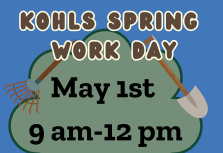
Opportunity Details
We need a group of volunteers or individuals to help with Spring Clean-Up at the Reserve. The tasks may include raking up old garden growth, transplanting old plants, pulling invasive plant garlic mustard and dames rocket basically helping us get ready for the summer season. This is a great spring fun opportunity to work outside!Available Shifts
| Shift Name | Signup Max | Start | End |
|---|---|---|---|
| Work crew | 20 | n/a | n/a |

Opportunity Details
Join Natural Restorations and OdySea Aquarium for a Lower Salt River Land and Water Cleanup on Saturday, March 30th from 8-11am. Hike along the riverbanks & explore the area while picking up trash or bring your SUP or kayak to help us remove trash from the river. We will wrap up with a free raffle at 11am. Everyone is welcome! Share & invite your friends! Register here: https://www.eventbrite.com/e/851085578877?aff=oddtdtcreator
Available Shifts
| Shift Name | Signup Max | Start | End |
|---|---|---|---|
| General | no limit | n/a | n/a |

Opportunity Details
Join Natural Restorations and OdySea Aquarium for a Lower Salt River Land and Water Cleanup on Saturday, March 30th from 8-11am. Hike along the riverbanks & explore the area while picking up trash or bring your SUP or kayak to help us remove trash from the river. We will wrap up with a free raffle at 11am. Everyone is welcome! Share & invite your friends! Register here: https://www.eventbrite.com/e/851085578877?aff=oddtdtcreator
Available Shifts
| Shift Name | Signup Max | Start | End |
|---|---|---|---|
| General | no limit | n/a | n/a |

Opportunity Details
A table staffed by knowledgeable representatives of Humane Action Pittsburgh can educate the public about HAP's mission and campaigns, raise awareness of the importance of animal and environmental advocates becoming politically involved, gain new HAP members, build the email list, and increase social media following.PURPOSE OF THE POSITION
- Ensure high public visibility for HAP within the community
- Promote HAP campaigns and advance animal protection by growing HAP membership through education and engagement of new people to the organization.
- Help HAP achieve our common goal of building the Model Humane City.
DUTIES AND RESPONSIBILITIES
- Transport literature and tabling supplies. Coordinate the pick-up and drop-off of materials as necessary
- Correspond with event organizers regarding details, such as tables and chairs needed and potential speaking opportunities
- Engage visitors at the HAP table and encourage them to sign up to receive information.
- Send data to supervisor
- If unable to answer a question from the public, obtain the answer from HAP leadership after and follow-up
- Respond to HAP leadership emails and calls within 48 hours
- Attend HAP's monthly leadership meeting and other meetings as needed
- Share and support HAP's mission and core values; adhere to HAP's policies
- Other duties as needed
TRAINING REQUIREMENTS
Training on HAP's core values, mission, and policies, including orientation on campaign missions and statuses.
SKILLS AND QUALIFICATIONS
- Excellent communication skills- both verbal and written
- An outgoing personality and eagerness to meet new people
- Self-motivated
- Ability to present yourself in a friendly, professional, and non-partisan manner
- Ability to work independently, follow instructions, and meet deadlines
- Working knowledge of Google Drive, Trello, or willingness to learn
TIME COMMITMENT REQUIRED
- Minimum of four events per year, events vary in time but usually 2-4 hours long, may need to travel to pick-up or drop-off supplies. Many events occur on evenings and weekends.
- Monthly one-hour, virtual leadership meetings
LOCATION
- Location varies; typically within the City of Pittsburgh
- Internal HAP meetings are virtual
DRESS CODE
Professional dress required for professional meetings (if any). If attending an informal event on behalf of HAP, we ask the volunteer to purchase a HAP t-shirt for $7.
BENEFITS TO VOLUNTEER
- Put your excellent people skills to work helping further animal protection issues!
- Know you are key to making a difference in the betterment of animals
- Opportunity to meet new people and network with community members and volunteers
- Be a valued HAP team member
- Build your resume
WHAT CAN VOLUNTEERS EXPECT FROM HAP
- Support of HAP leadership and members
- Respect and appreciation for your contribution and input
